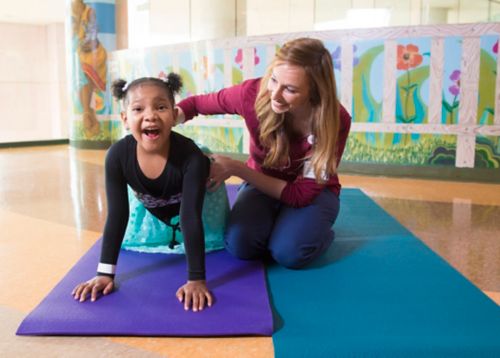St. Jude Family of Websites
Explore our cutting edge research, world-class patient care, career opportunities and more.
St. Jude Children's Research Hospital Home

- Fundraising
St. Jude Family of Websites
Explore our cutting edge research, world-class patient care, career opportunities and more.
St. Jude Children's Research Hospital Home

- Fundraising
Yoga rehab helps pineoblastoma patient regain strength, coordination

Jessica Sparrow, occupational therapist in Rehabilitation Services, and 5-year-old St. Jude patient, Trinity Cunningham, practice yoga.
Five-year-old Trinity Cunningham, knows how to strike a pose. Yoga is an important part of her rehabilitation plan as a patient at St. Jude. In Trinity’s words, she practices yoga to “get strong.”
In the spring of 2015, Trinity often reported weakness, headaches, nausea and extreme sensitivity to bright lights. Trinity’s mother, Sherry Cunningham, sought help for her then 3-year-old daughter.
Eventually, a brain scan confirmed the presence of a fast-growing tumor called pineoblastoma—its name taken from its location in the pineal gland, a small organ near the center of the brain.
Trinity underwent an intense treatment regimen of chemotherapy, surgery and radiation; unfortunately, the side effects of treatment can also be severe. In Trinity’s case, she needed rehabilitation to regain her strength and coordination.
“In occupational therapy, we work to strengthen Trinity’s core, upper body and hands so that she can gain better control over her movements and do the things she wants to do like color, write and play Candyland."
– Jessica Sparrow
Trinity’s occupational therapist who works in the St. Jude Rehabilitation Services
Sparrow uses yoga to complement standard interventions. In fact, a growing body of research highlights the health benefits of yoga for children: less anxiety and pain, increased strength and flexibility, and improved mental functioning.
“Trinity brightens the day of everyone with beautiful singing, super cool beatboxing or a funny story,” Sparrow said. “She’s an amazingly hard worker.”
And that hard work is paying off. Trinity is flourishing in what occupational therapists call the “occupations” of childhood: learning, playing and growing. Trinity attends kindergarten, where she’s learning her letters. She plays with classmates, and she loves to shop at the mall.
Cuningham vividly remembers when her daughter was languishing, the time just before the diagnosis. Trinity would repeatedly say, “Mom, I want to look at TV.” Trinity desperately wanted to watch TV, but the bright light caused her intense pain. She would turn away and “ball up into a knot.”
Now, with a few deep breaths, Trinity can transform into a lion, walrus, polar bear or another creaturely pose. But when you think about Trinity’s hard work and determination, the most fitting yoga pose for her is probably tree pose: one foot planted on the ground, trunk unbowed, eyes fixed straight ahead, balanced (though still a little wobbly), with arms stretched out wide.
For information on incorporating yoga into your child’s routine, read “Do You Know…Yoga for Kids.” If you have questions or concerns before your child begins a yoga practice, talk to your child’s doctor.






